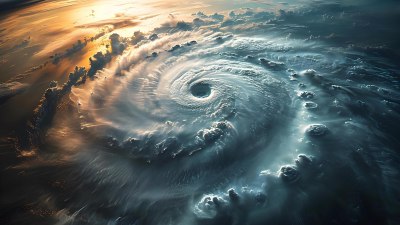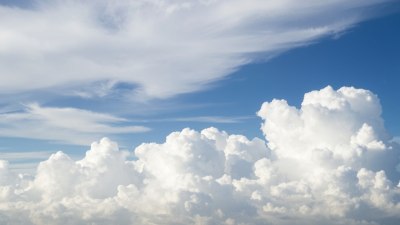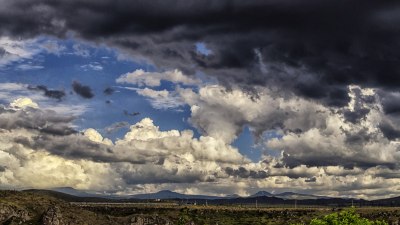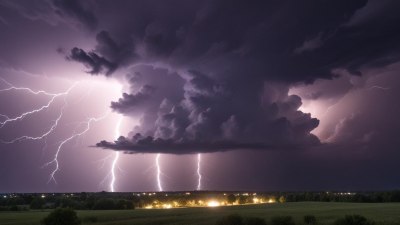Can Two Hurricanes Collide? What Happens When Storms Meet
Explore the science behind hurricanes colliding and the meteorological phenomena that occur.

Image by nastiklis1992 on Freepik
Hurricanes, also known as typhoons or cyclones, are powerful tropical storms that form over warm ocean waters. They are characterized by high winds, heavy rainfall, and low-pressure centers. The interaction between two hurricanes presents a fascinating area of study in meteorology. Understanding what happens when two storms meet not only enriches our knowledge of these natural phenomena but also enhances predictive models that can save lives and property. This article will delve into the dynamics of hurricane collisions, the conditions necessary for them to occur, and the potential outcomes of such interactions.
Understanding Hurricane Formation
Before we investigate the collision of hurricanes, it's essential to understand how they form. Hurricanes develop over warm ocean waters, typically in tropical regions, where the sea temperature is at least 26.5 degrees Celsius (about 80 degrees Fahrenheit). This warmth causes moisture in the air to evaporate, rising and creating a low-pressure area. The Coriolis effect, due to the Earth's rotation, causes this rising air to spin and create a cyclone. As more moist air feeds into the system, the storm strengthens and organizes into the well-known structure of a hurricane.
The Lifecycle of a Hurricane
A hurricane goes through several stages during its lifecycle: tropical disturbance, tropical depression, tropical storm, and finally, a fully developed hurricane. Each stage is characterized by increasing wind speeds and organized circulation. When hurricanes are fully formed, their wind speeds must reach at least 74 miles per hour to be classified as hurricanes. Understanding these stages and the energy dynamics involved is crucial when considering the possibility of two hurricanes colliding.
The Concept of Hurricane Interaction
When we talk about hurricanes colliding or interacting, meteorologists often refer to two processes: the Fujiwhara effect and direct collisions. The Fujiwhara effect occurs when two cyclonic systems are close enough to each other so that their circulations begin to interact. This can lead to one storm being absorbed into another or the two storms rotating around a common center. Direct collisions, although less common, can result in dramatic changes to the storms’ structure and intensity.
The Fujiwhara Effect
The Fujiwhara effect was named after Japanese meteorologist Sakuhei Fujiwhara, who described this phenomenon in the early 20th century. It occurs when two cyclones come within 900 miles of each other. Each storm begins to exert gravitational attraction on the other, causing them to rotate around a common point. The result can vary widely: one hurricane may merge with another, weaken, or in some cases, the two storms could spin together, forming a composite system. This interaction can significantly alter the path and intensity of the storms, sometimes leading to a more dangerous weather system or even diminishing their strength.
What Happens When Two Hurricanes Meet?
The outcome of a hurricane meeting another hurricane can depend on several factors, including their respective sizes, strengths, and distances apart. If both storms are of similar strength, they may engage in a more complex interaction involving downward spiral movements, where the wind patterns from each storm can cause significant changes to their structures. Hurricanes tend to conserve their energy, so the interaction often leads to one storm absorbing the other. The absorbed storm feeds energy into the dominant storm, potentially causing an increase in intensity and size. However, if one storm is significantly more powerful, it may simply weaken the other before absorption, leading to a reduction in the total energy output.
Historical Examples of Hurricane Interactions
Throughout history, there have been notable instances where hurricanes have interacted or collided. One famous case is Hurricane Rita and Hurricane Katrina in 2005. Although they were not in direct collision, their paths brought them close together in the Gulf of Mexico. The interaction caused changes in wind patterns, influencing the path and strength of Hurricane Rita. In some instances, this dynamic interaction can lead to a temporary increase in rainfall and wind speeds for one of the storms and lead to erratic behavior in both systems.
Conditions Favoring Hurricane Interaction
For two hurricanes to interact significantly, certain atmospheric conditions must be present. First, both storms need to be sufficiently distanced to allow their circulations to overlap. Second, specific environmental conditions, such as low wind shear and warm ocean temperatures, can facilitate their merging. Conversely, if conditions are harsh, like high wind shear, it can prevent the storms from interacting at all. Additionally, other weather patterns like high-pressure systems can affect their paths, determining if they will meet or repel each other.
Consequences of Hurricane Collisions
The consequences of a hurricane collision or interaction can be severe. Merged storms can lead to increased wind speeds significantly, and the compounding of rain around an area can lead to flooding. For coastal areas, this means higher storm surges and greater risk of damage. Additionally, the shifts in the storm's track can lead to unexpected consequences for communities far from the initial storm paths. Emergency management must be prepared for such unpredictable events, as the potential for significant impact increases with simultaneous cyclone events.
The Role of Technology in Monitoring Hurricanes
Advancements in meteorological technology have significantly improved our understanding and monitoring of hurricanes. Satellite imagery, Doppler radar, and computer modeling help researchers predict hurricane behavior and interactions with greater accuracy. These tools allow for close monitoring of storms as they develop, alerting meteorologists to potential interactions well in advance, providing critical information to communities in the storm’s path. Continuous data collection and analysis allows for better anticipation of hurricane impacts, giving emergency services the information needed to respond effectively.
Hurricane Preparedness and Public Awareness
While the possibility of two hurricanes colliding is relatively rare, the risks associated with powerful storms require a high level of preparedness from communities. Organizations such as the Federal Emergency Management Agency (FEMA) emphasize the importance of having an emergency plan in place. This includes understanding evacuation routes, creating an emergency kit, and staying informed about weather updates. Public awareness campaigns can educate citizens on the potential impacts of storm interactions, urging vigilance and preparedness.
The phenomenon of two hurricanes colliding or interacting is a captivating and critical area of study in meteorology. While difficult to predict precisely, the scientific community continues to develop techniques and technologies to improve forecasting and enhance understanding of these complex storms. As our understanding of the dynamics between hurricane systems evolves, so does our ability to prepare for and mitigate the impacts of extreme weather events. By fostering greater awareness and preparedness, communities can better weather the storms—and perhaps even two storms at once.











